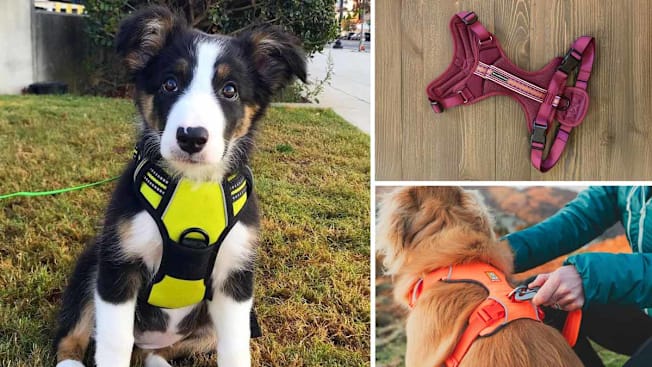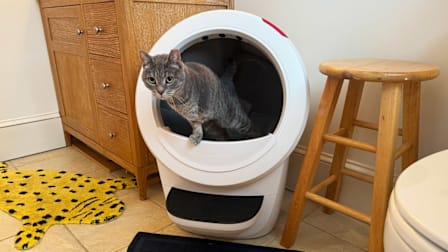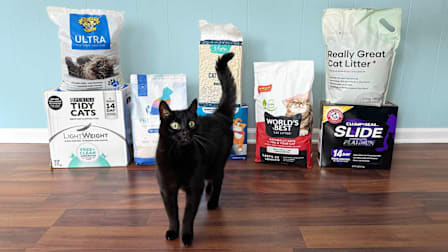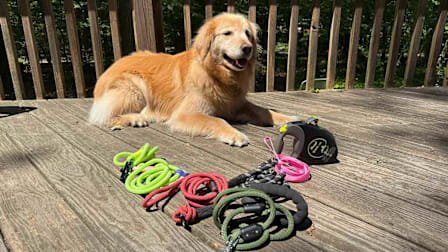Best Dog Harnesses of 2025
We chose popular picks from brands such as PetSafe, Rabbitgoo, and Wilderdog and enlisted four clever canines to help us test them. Here are the Best in Show.
When you shop through retailer links on our site, we may earn affiliate commissions. 100% of the fees we collect are used to support our nonprofit mission. Learn more.

Like most couples, my wife Sally and I have a few disagreements about fundamentally important issues. In our case, it’s often about how best to walk the dog.
How to Get the Right Fit for Your Dog Harness
A proper fit is very important for safety and security, according to Kate Perry, a New York-based dog trainer and author of "Training for Both Ends of the Leash" (Avery, 2012).
"It should be snug, but not too snug," she says. If a harness is too tight—or tight in the wrong places—it can cause injury when the dog pulls on the leash and the harness. But if it’s not tight enough, your dog can wriggle out and run away.
Getting the proper fit involves checking the manufacturer’s website and measuring your dog, according to the instructions. Despite following the manufacturer’s instructions carefully, however, we still found the fit to be too loose on a couple of models, even after tightening the harness as much as possible. "There’s no one-size-fits-all," says Perry. "Every dog is a different shape and size."
With the proper fit, she says, you should be able to slip one finger comfortably between the harness and the dog’s fur. Going one step further, she suggests letting your dog try a controlled escape. In a secure area, step on the leash just in front of the dog to see whether it can wriggle out. If the harness is too loose, tighten the straps, and if that doesn’t work, get a smaller-sized harness. To be safe, Perry also recommends leaving a conventional collar with ID tags on the dog, just in case it does manage to squirm out of the harness.
Before we go any further, we’ll admit that harnesses are a controversial topic in the dog-lover community. Some trainers swear by them, maintaining that it’s more humane to attach a leash to a dog’s body than to its neck. Others swear at them, suggesting that they encourage pulling—sled dogs also wear harnesses—and can make it more difficult to train a dog to walk calmly, because the harness mutes the intentions that you might be trying to communicate through gentle inputs on the leash.
The Pulling Problem
As noted above, most harnesses have two ways to secure the leash. The first is a ring on the dog’s back, a system not dissimilar to what Alaskan sled dogs use. The wide front pad of the harness distributes pressure across the strong muscles and bones of a dog’s chest, so it’s quite comfortable. Or so my dog Rugby tells me. On the other hand, research shows that a harness that allows a dog to pull hard without discomfort encourages many canines to do just that.
According to a paper published in the Journal of Veterinary Behavior this year by Joshua Bailey and a team of researchers from Southern Illinois University, dogs will pull almost twice as hard when wearing a harness instead of a flat nylon collar attached to a leash. This finding was consistent across dogs of all sizes, with smaller dogs pulling even harder, pound for pound, than larger ones. "Some of those dogs are pulling in excess of their body weight," says SIU veterinary professor Erin Perry, who oversaw Bailey’s research. "It’s a medical concern for the dogs, and it’s a medical concern for the humans."
The problem, according to SIU’s Perry, is that even a relatively small dog, excited by routine stimuli like a squirrel or a snack, can pull hard enough to knock a human being off-balance. If this forceful pulling leads to fewer walks, she says, the resulting lack of exercise and stimulation can lead to the kind of destructive behaviors that prompt dog owners to surrender their pets to a shelter, which is bad for everyone.
That ring in the front? Trainer Kate Perry says that it can be used as a training tool to discourage pulling. If the dog tries to tug on the leash and walk ahead, it will spin around almost 180 degrees, leaving it facing backward, looking at the person holding the leash. Done in a controlled environment, this can help teach leash manners.
However, a harness with a front-mounted leash loop isn’t a foolproof solution, says SIU’s Perry. If a dog continues to pull, that can inhibit the dog’s natural gait, which could, in turn, lead to chronic injuries.
"There is no magic collar or harness," says professor Perry. "You have to train your dog. Unfortunately, there’s no shortcut."
So our recommendation is to monitor your dog carefully, and if the harness encourages your dog to pull, consult with a trainer or your vet about how to teach your pet to use a harness properly.
To help you find the best harness for your dog, we selected five popular options from brands such as Wilderdog, PetSafe, and Rabbitgoo and enlisted friends with dogs of different sizes to help us evaluate them. Before we dive into what we learned, here’s a closer look at our four-legged testers.
Meet Our Dog Harness Judges
Rugby: At more than 50 pounds, my dog Rugby is the group’s heavyweight. She’s an 8-year-old golden retriever named after the southwest Virginia hometown of the legendary guitar builder Wayne C. Henderson. She’s generally very well behaved on a leash, but her laid-back demeanor can sometimes go out the window if she sees a squirrel or a chipmunk.

Photos: Allen St. John/Consumer Reports, Benedetta Balsimelli, and Sharon Pollack Photos: Allen St. John/Consumer Reports, Benedetta Balsimelli, and Sharon Pollack
Berry: A four-year-old Jack Russell terrier, Berry loves sleeping in the family’s laundry basket. Walks? He can take them or leave them, but he feels most secure when he’s wearing a full harness. The muscular 23-pounder, by the way, got his name from his human brother’s once-favorite food.
Moxie: A year-old Goldendoodle, Moxie is the rookie of our team. She’s still learning leash manners, so walking her can be a bit of an adventure for owners Sharon and Cathy. When she’s not on a walk, the 31-pound canine has a passion for playing fetch. Usually, she pursues a dog toy, but at times she’ll grab something less appropriate, like Sharon’s passport.
Bianca: Berry’s housemate, Bianca, is a 24-pound, food-motivated mixed breed that’s a little afraid of car rides. Partly a puppy at around 2 years of age, she’s solidly excitable. "She’ll pull like crazy chasing a squirrel," says owner Benedetta. Her favorite trick? Stealing Berry’s blanket . . . and then refusing to give it back.




















